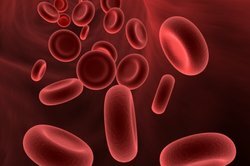How is the blood transported in the veins?
Heart and blood vessels, such as veins and arteries, make up the human cardiovascular system. The system supplies the body with nutrients and oxygen. In addition, this disposes of degradation products and transports hormones, immune systems, heat and water. All of these tasks are performed by the blood flowing through the veins and arteries. But how exactly is the blood transported?

The body circulation - a large circulation of veins and arteries
- The body's circulation supplies the human organs with oxygen and nutrients from the left ventricle via the arteries and their branches.
- Low-oxygen blood collects in the veins and is transported from there to the right atrium of the heart via the upper and lower vena cava.
- In addition to the fats, nutrients from the intestine are first transported to the liver via the portal vein.
- These are processed in the liver and then fed into the body's circulation via the inferior vena cava.
- The fats in the blood are carried by the lymph through a large lymph vessel into the superior vena cava.
The human body has changed in the course of evolution. The development from ...
The small circulation or pulmonary circulation
- In the lungs, oxygen-poor blood is removed from the body to the right atrium of the heart and from there through the right ventricle into the lungs.
- In the alveoli, the blood absorbs oxygen and releases carbon dioxide.
- After passing through the lungs, the blood enters the left atrium and the left ventricle; from there it is transported into the circulatory system via the aorta.
Veins - this is where the blood is transported
Veins are small vessels that carry blood to the heart. The veins in the body's circulation contain oxygen-depleted blood. Here the blood is dark red. The vein carries oxygen-rich blood in the lungs. This is light red.
- Veins contain pocket flaps with a valve function. With this function, the blood can only flow towards the heart.
- The flow of blood in the veins is generated by movements of the skeletal muscles - also known as the muscle pump - and by the suction force of the heart.
- The muscle pump works as follows: When the surrounding skeletal muscles (e.g. B. when walking) the veins compress and thereby press the blood to the heart.
- On the leg there are deep veins and those below the skin superficial veins nor perforating veins, which direct the blood from the superficial veins into the deep leg veins.
- In older age, the veins often lose their function with slackening and widening of the vein walls, the well-known varicose veins.
How helpful do you find this article?
The content of the pages of www.helpster.de was created with the greatest care and to the best of our knowledge and belief. However, no guarantee can be given for the correctness and completeness. For this reason, any liability for possible damage in connection with the use of the information offered is excluded. Information and articles must under no circumstances be viewed as a substitute for professional advice and / or treatment by trained and recognized doctors. The content of www.helpster.de cannot and must not be used to make independent diagnoses or to start treatments.


